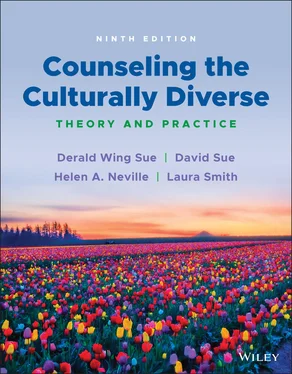90 Wood, P. S., & Mallinckrodt, B. (1990). Culturally sensitive assertiveness training for ethnic minority clients. Professional Psychology: Research & Practice, 21, 5–11.
91 Ziegler, K., & Camarota, S. (2019). 67.3 million in the United States spoke a foreign language at home in 2018. Retrieved from https://cis.org/Report/673‐Million‐United‐States‐Spoke‐Foreign‐Language‐Home‐2018
PART 2 Sociopolitical and Social Justice Dimensions of Multicultural Counseling and Therapy
Chapter 4Microaggressions: Implications for Counseling and Psychotherapy
Chapter 5Sociocultural Privilege and Oppression: Implications for Counseling and Psychotherapy
CHAPTER 4 Microaggressions: Implications for Counseling and Psychotherapy
CHAPTER OBJECTIVES
1 Define and describe microaggressions.
2 Differentiate between the intentions (by the aggressor) and the impact (on the victim) of microaggressions.
3 Understand the harmful psychological impact of microaggressions on marginalized groups.
4 Describe the four psychological dynamics involved in microaggressions.
5 Apply knowledge of microaggressions to understanding the therapeutic process and client/counselor dynamics.
6 Define “microinterventions” and discuss how they are used to disarm microaggressions.
Full Counseling Session video (Part I): “ Microaggressions in Counseling ” (features “Marilyn” and “Al”)
Jaylen, an African American male
It gets so tiring, you know. It sucks you dry. People don't trust you. From the moment I [Black Man] wake up, I know stepping out the door, that it will be the same, day after day. The bus can be packed, but no one will sit next to you… . I guess it may be a good thing because you always get more room, no one crowds you. You get served last … when they serve you, they have this phony smile and just want to get rid of you… . you have to show more ID to cash a check, you turn on the TV and there you always see someone like you, being handcuffed and jailed. They look like you and sometimes you begin to think it is you! You are a plague! You try to hold it in, but sometimes you lose it. Explaining doesn't help. They don't want to hear. Even when they ask, ‘Why do you have a chip on your shoulder?’ Shit … I just walk away now. It doesn't do any good explaining. (Sue, 2010, p. 87)
REFLECTION AND DISCUSSION QUESTIONS
1 If this were one of your clients in counseling and therapy, what thoughts or reactions would you have as you listened to Jaylen's story?
2 Is life as hard as this Jaylen describes? Are these experiences real or is he exaggerating and misreading the action of others?
3 Some may say that Jaylen is oversensitive and even paranoid. As a mental health professional, how would you ascertain the legitimacy of his assertions?
4 He seems to imply that others (White people) do not want to listen to his explanations. What would lead him to such a conclusion?
5 Jaylen appears angry and resentful. Are these responses dysfunctional and pathological?
Melanie, a recently hired White female faculty member
I don't know what it was … I should have felt excited and honored to be at (Ivy League Institution), one of the top universities in the country. The Program Chair made me feel welcomed during the interview process and during my job talk. However, during my first week here, I felt unwelcome, isolated, unsafe and alienated. It started with the new faculty orientation. We were all standing during a tour of the main conference room, and I noticed that every single past president of the university were White men. When I scanned the group of new faculty, I also noticed that there was only two other women in the group. The men in the group, even though they not know one another, seemed to make friends quickly. They were talking about sports and especially the football playoffs. I tried to enter the conversation but was ignored. At least, that's what I felt. Was I being oversensitive?
I noticed the other two women were also by themselves and considered going over to them, but didn't want to appear antisocial to the men. Later that week, I was introduced to a senior faculty member in the Department. “Oh, he said, ‘you must be the new female faculty member we hired to replace Jess. Welcome, but I always believe a hiring decision should be based upon competence and not gender or race. I hope you are up to the task. Men don't stand a chance these days. We take pride in being on the cutting edge of scholarship, and don't tolerate ‘slackards.” He was very abrupt and unfriendly. I couldn't believe it! His comments made me so angry. It was insulting! Does he think I'll sit in my office and eat bon bons all day? I thought, what have I gotten myself into?
REFLECTION AND DISCUSSION QUESTIONS
1 If this were one of your clients, what is your assessment as to what is happening to Melanie?
2 Does Melanie have a reason for feeling unsafe, unwelcomed and alienated? What factors may be contributing to this feeling?
3 Should Melanie simply “toughen up” in order to make it in a highly competitive institution? Is she “oversensitive to slights?”
4 As a woman, have you ever experienced similar situations? Can you describe them? When such “slights” or exclusions occur, what impact did it have on you? How did it make you feel? How did you deal with it?
5 As a man, have you ever been aware of, or witnessed such interactions? What are your thoughts about the actions of her male colleagues? Have you ever behaved in a similar way?
Counselors and therapists need to understand the worldviews of clients in order to form a therapeutic working relationship. This is oftentimes a major challenge for helping professionals who do not share the lived reality of their culturally diverse clients. The result is a breakdown or rupture in the therapeutic coalition that may lead to misunderstandings, discomfort, and premature termination (Muran, Eurbanks, & Samtag, 2020; Smith & Trimble, 2016). In the two above examples, we are witnessing the manifestation of racial and gender microaggressions in the lived experience of Jaylen and Melanie. Many times these offensive encounters go unnoticed by perpetrators and onlookers. It is equally damaging when counselors fail to recognize how they affect women and clients of color when they tell stories of microaggressive encounters. As we will shortly see, a failure to recognize the racial or gender overtones of client experiences leads to a common form of microaggression committed by therapists.
Microaggressionsare the everyday slights, indignities, putdowns, insults, and invalidations that marginalized group members experience in their day‐to‐day interactions with well‐intentioned people who often are unaware they have engaged in an offensive and demeaning manner (Pierce, Carew, Pierce‐Gonzales, & Willis, 1978; Sue & Spanierman, 2020). Any marginalized group in our society can be the object of microaggressions. Microaggressions are reflections of implicit bias or attitudes and beliefs outside the level of conscious awareness. They are powerful because their manifestation reflect a worldview of inclusion–exclusion, superiority–inferiority, and normality–abnormality (Torino, Rivera, Capodilupo, Nadal, & Sue, 2019). Microaggressions often send hidden demeaning or humiliating messages to targeted individuals. Far from being harmless, trivial, and insignificant, they have major detrimental impact on the physical and psychological well‐being of targets (Williams, 2020a, 2020b). Let us return to our two opening narratives to extract some important lessons.
Читать дальше












